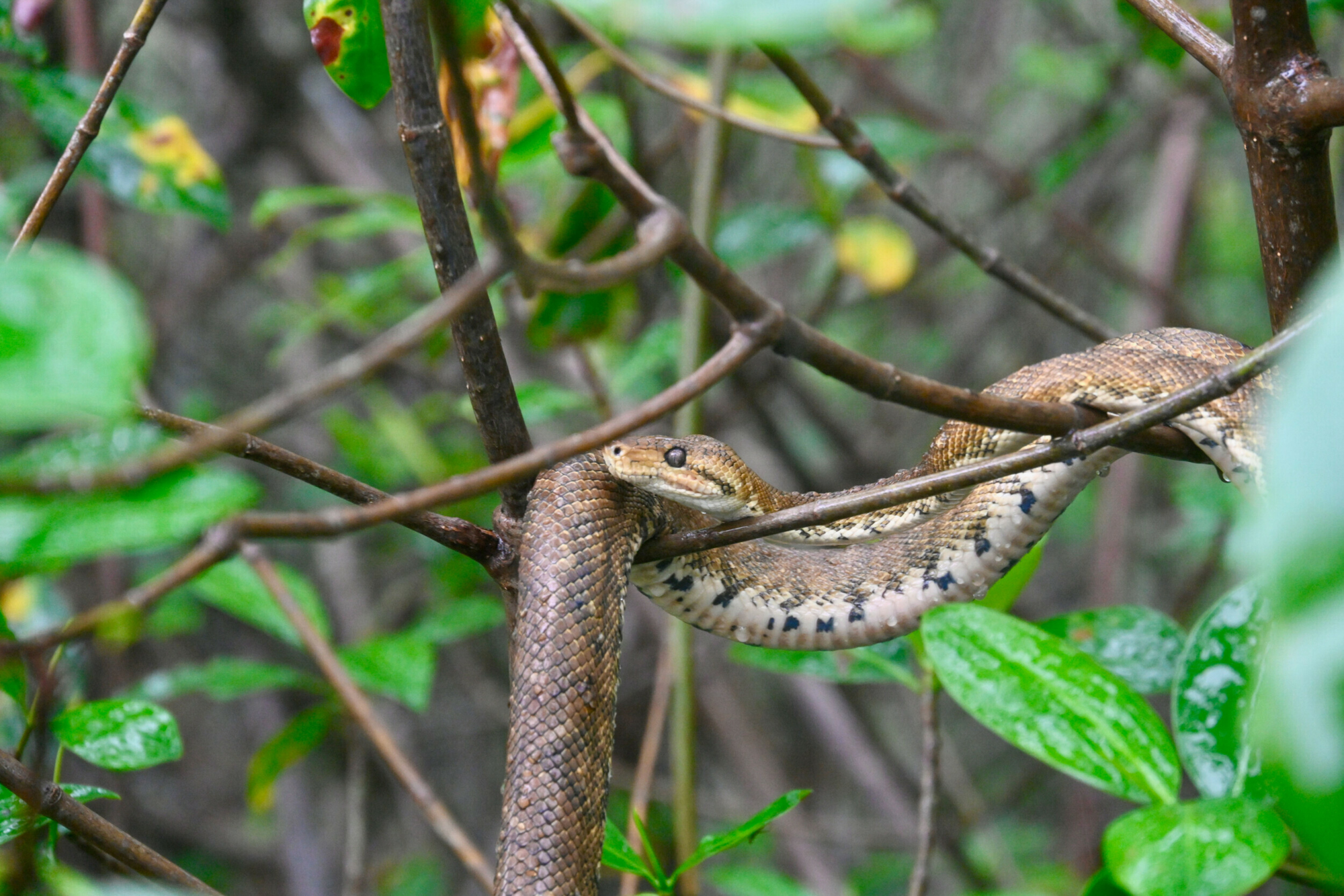Embracing the Wild: A Boa Constrictor's Realm in Damas Mangrove, Costa Rica

Introduction
In the lush green labyrinth of Costa Rica's Damas Mangrove, the boa constrictor reigns supreme. This exquisite serpent, with its intricate patterns and formidable presence, embodies the untamed beauty of Central American wildlife. Through the lens of a camera, we capture not just an image but a narrative—a glimpse into a day in the life of the Boa constrictor imperator, a silent whisperer among the tangled roots of the mangroves.
The Majesty of the Boa Constrictor
The Boa constrictor imperator is a marvel of evolution, perfectly adapted to its environment. With a muscular body that can reach impressive lengths, it is a non-venomous constrictor that subdues prey with its strength. Its scales shimmer with earthy hues, allowing it to disappear into the surrounding foliage with ease. Observing its slow, deliberate movements reveals a creature in perfect harmony with its surroundings, playing a vital role in the balance of the ecosystem.
Damas Mangrove: A Biodiversity Hotspot
Damas Mangrove, accessible from the renowned Manuel Antonio National Park, stands as a sentinel of biodiversity. These unique coastal forests are critical to the health of our planet's oceans and serve as nurseries for marine life. They act as buffers, protecting inland areas from storms and erosion. The mangroves are not just trees; they are a complex, interwoven community of plants and animals, each with a role in an intricate ecological ballet.
The Art of Capturing a Boa Constrictor on Camera
Photographing a boa constrictor in the wild is a testament to patience and resilience. The camera settings—a shutter speed of 1/80, aperture at f/6.3, and ISO at a high 3200—were chosen to counteract the dim lighting under the mangrove canopy. The Nikon 24.0-200.0 mm lens at a focal length of 135mm allowed for a detailed yet broad composition, bringing the viewer into the boa's domain without disturbing its natural behavior.
The Impact of Seasonality on Wildlife Photography
The time of year is a pivotal factor in wildlife photography. The dry season, with its clearer skies and less dense foliage, provides ample lighting and visibility. Conversely, the rainy season offers a backdrop of vibrant life, with raindrops adding texture and a sense of immediacy to the images. Each season demands a unique approach to capture the essence of the mangrove and its inhabitants.
Connection to Culture and Community
The boa constrictor, often misunderstood, holds a place of respect in local lore. It is seen as a guardian of the forests, a symbol of wisdom in indigenous mythology. The rise of eco-tourism has brought a renewed appreciation for these creatures, fostering a symbiotic relationship between the local economy and the preservation of natural habitats.
Technical Deep Dive: The Nitty-Gritty of the Shot
Delving into the EXIF data reveals the technical choices behind the photograph. The choice of a high ISO compensates for the low light, while the shutter speed balances the need to freeze motion without introducing too much noise. The specific lens used provides the sharpness and clarity needed to bring out the textural details of the snake's skin.
Conservation: Coexisting with Boa Constrictors
The boa constrictor faces numerous threats, from habitat loss to the illegal pet trade. Conservation efforts focus on habitat protection and public education, aiming to foster a world where humans and serpents can coexist peacefully. Wildlife photography plays a crucial role in these efforts, using the power of images to spark conversation and inspire action.
Personal Reflections and Experiences
The journey through Damas Mangrove is more than a photographic expedition; it is a personal odyssey. Each sighting of the boa constrictor is
a profound reminder of the delicate threads that weave the tapestry of our ecosystem. My encounter with this majestic creature was not just a moment captured in time; it was an intimate dialogue with nature, a reminder of the fragility and resilience that coexist in these verdant corridors.
Conclusion
As we emerge from the shadows of the mangroves, we carry with us not just photographs but stories, lessons, and a deeper understanding of our world. The image of the boa constrictor, a creature of both beauty and myth, stands as a testament to the art of photography and the importance of conservation. It beckons us to become stewards of our planet, to protect the wild not only for its inhabitants but for future generations to witness.
Frequently Asked Questions (FAQs)
- What adaptations do boa constrictors have for their environment? Boa constrictors have several adaptations, including their camouflaged skin, muscular bodies for constricting prey, and labial pits for detecting heat from warm-blooded animals in their habitat.
- Why are mangroves important for ecosystems? Mangroves are crucial for ecosystems as they provide a habitat for a myriad of species, protect coastlines from erosion, offer a buffer against storms, and play a role in carbon sequestration.
- How can one responsibly visit mangrove forests without disturbing the wildlife? Visitors should follow designated paths, maintain a respectful distance from wildlife, refrain from littering, and choose eco-friendly tours that prioritize the environment.
- What are the biggest threats to boa constrictors in the wild? Habitat destruction, illegal wildlife trade, and being killed out of fear are significant threats to boa constrictors.
- How can photography aid in the conservation of species like the boa constrictor? Photography can raise awareness, educate the public about these species' importance, and evoke empathy, prompting conservation action.
- What should photographers consider when capturing wildlife in their natural habitat? Photographers should prioritize the well-being of the wildlife, use appropriate camera settings to handle the natural light without flash, and aim to tell a story through their images that respect the animal's integrity.
- Are there any conservation efforts in place to protect the wildlife in Costa Rica's mangroves? Costa Rica has several conservation programs and protected areas to preserve its biodiversity, including the mangroves. Efforts include habitat protection, research, and sustainable tourism practices.
